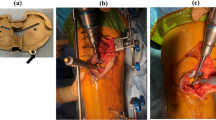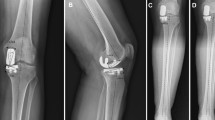Abstract
Purpose
Joint line orientation (JLO) plays an important role in total knee arthroplasty (TKA), but its influence on patient-reported outcomes (PROs) is unclear. The purpose of this study was to examine JLO impact as measured by the forgotten joint score (FJS-12). The hypothesis was that restoring the joint line (JL) parallel to the floor would influence joint awareness favorably, i.e., allow the patient to forget about the joint in daily living.
Methods
All computer-navigated primary TKAs using a cemented, cruciate-retaining (CR) design implanted between January 2018 and September 2019 were reviewed in this retrospective single-center analysis. Primary endpoints were: clinical [range of motion (ROM)], and patient-reported (FJS-12) and radiographical outcomes [tibia joint line angle (TJLA), hip knee axis (HKA), mechanical medial proximal tibia angle (mMPTA) as well as mechanical lateral distal femoral angle (mLDFA)].
Results
Seventy-six patients (mean age: 70.3 ± 9.7 years, mean BMI: 29.7 ± 5.2 kg/m2) were included. Postoperative ROM averaged 118.7 ± 9.6°. The mean FJS-12 improved from 16.4 ± 15.3 (preoperatively) to 89.4 ± 16.9 (1-year follow-up; p < 0.001). Clinical outcomes and PROs did not correlate with JLO (p = n.s.). Cluster analysis using six measures revealed that a medially opened TJLA was associated with significantly better postoperative FJS-12.
Conclusion
Tibial JLO was found to have no effect on PROs. Considering the JLO in the coronal plane alone probably has questionable clinical relevance. Lower limb alignment should be assessed in all three planes and correlated with the clinical outcome.
Level of clinical evidence
Level IV.



Similar content being viewed by others
Abbreviations
- CR:
-
Cruciate retaining
- FJS-12:
-
Forgotten joint score-12
- HKA:
-
Hip knee ankle axis
- ICC:
-
Interclass correlation coefficient
- JL:
-
Joint line
- JLO:
-
Joint line orientation
- KA:
-
Kinematic alignment
- MA:
-
Mechanical alignment
- MCID:
-
Minimal clinically important difference
- mLDFA:
-
Mechanical lateral distal femoral angle
- mMPTA:
-
Mechanical medial proximal tibial angle
- PRO:
-
Patient-reported outcome
- ROM:
-
Range of motion
- TJLA:
-
Tibia joint line angle
- TKA:
-
Total knee arthroplasty
References
Behrend H, Giesinger K, Giesinger JM, Kuster MS (2012) The “forgotten joint” as the ultimate goal in joint arthroplasty. J Arthroplasty 27:430-436.e1
Bellemans J, Colyn W, Vandenneucker H, Victor J (2012) The Chitranjan Ranawat Award and colon; is neutral mechanical alignment normal for all patients?; The concept of constitutional varus. Clin Orthop Relat Res 470:45–53
D’Amato M, Kosse NM, Wymenga AB (2020) Restoration of pre-operative joint line orientation and alignment does not affect KSS and KOOS 1 year after total knee arthroplasty. Knee Surg Sports Traumatol Arthrosc. https://doi.org/10.1007/s00167-020-06097-z
Hess S, Moser LB, Amsler F, Behrend H, Hirschmann MT (2019) Highly variable coronal tibial and femoral alignment in osteoarthritic knees: a systematic review. Knee Surg Sports Traumatol Arthrosc 27:1368–1377
Hirschmann MT, Hess S, Behrend H, Amsler F, Leclercq V, Moser LB (2019) Phenotyping of hip–knee–ankle angle in young non-osteoarthritic knees provides better understanding of native alignment variability. Knee Surg Sports Traumatol Arthrosc 27:1378–1384
Hirschmann MT, Konala P, Amsler F, Iranpour F, Friederich NF, Cobb JP (2011) The position and orientation of total knee replacement components: a comparison of conventional radiographs, transverse 2D-CT slices and 3D-CT reconstruction. J Bone Joint Surg Br 93:629–633
Hirschmann MT, Moser LB, Amsler F, Behrend H, Leclercq V, Hess S (2019) Phenotyping the knee in young non-osteoarthritic knees shows a wide distribution of femoral and tibial coronal alignment. Knee Surg Sports Traumatol Arthrosc 27:1385–1393
Hirschmann MT, Moser LB, Amsler F, Behrend H, Leclerq V, Hess S (2019) Functional knee phenotypes: a novel classification for phenotyping the coronal lower limb alignment based on the native alignment in young non-osteoarthritic patients. Knee Surg Sports Traumatol Arthrosc 27:1394–1402
Howell SM, Howell SJ, Kuznik KT, Cohen J, Hull ML (2013) Does a kinematically aligned total knee arthroplasty restore function without failure regardless of alignment category? Clin Orthop Relat Res 471:1000–1007
Hutt J, Massé V, Lavigne M, Vendittoli P-A (2016) Functional joint line obliquity after kinematic total knee arthroplasty. Int Orthop 40:29–34
Ingelsrud LH, Roos EM, Terluin B, Gromov K, Husted H, Troelsen A (2018) Minimal important change values for the Oxford Knee Score and the Forgotten Joint Score at 1 year after total knee replacement. Acta Orthop 89:1–7
Giesinger JM, Behrend H, Hamilton DF, Kuster MS, Giesinger K (2018) Normative values for the Forgotten Joint Score-12 for the U.S. general population. J Arthroplasty 34:650–655
Ward JH (2012) Hierarchical grouping to optimize an objective function. J Am Stat Assoc 58:236–244
Lee YS, Howell SM, Won Y-Y, Lee O-S, Lee SH, Vahedi H, Teo SH (2017) Kinematic alignment is a possible alternative to mechanical alignment in total knee arthroplasty. Knee Surg Sports Traumatol Arthrosc 25:3467–3479
Li Y, Gao Y-H, Lu-Ding LJ, Yang C, Li M, Qi X (2019) Analysis of the effect of tibial torsion on tibial osteotomy in knee arthroplasty using a three-dimensional computed tomography-based modelling technique. BMC Musculoskelet Disord 20:361
Matsumoto T, Takayama K, Ishida K, Hayashi S, Hashimoto S, Kuroda R (2017) Radiological and clinical comparison of kinematically versus mechanically aligned total knee arthroplasty. Bone Joint J 99-B:640–646
McEwen PJ, Dlaska CE, Jovanovic IA, Doma K, Brandon BJ (2020) Computer-assisted kinematic and mechanical axis total knee arthroplasty: a prospective randomized controlled trial of bilateral simultaneous surgery. J Arthroplasty 35:443–450
Moser LB, Hess S, Amsler F, Behrend H, Hirschmann MT (2019) Native non-osteoarthritic knees have a highly variable coronal alignment: a systematic review. Knee Surg Sports Traumatol Arthrosc 27:1359–1367
Niki Y, Nagura T, Nagai K, Kobayashi S, Harato K (2018) Kinematically aligned total knee arthroplasty reduces knee adduction moment more than mechanically aligned total knee arthroplasty. Knee Surg Sports Traumatol Arthrosc 26:1629–1635
Paley D, Pfeil J (2000) Prinzipien der kniegelenknahen Deformitätenkorrektur. Orthopade 29:18–38
Rames RD, Mathison M, Meyer Z, Barrack RL, Nam D (2018) No impact of under-correction and joint line obliquity on clinical outcomes of total knee arthroplasty for the varus knee. Knee Surg Sports Traumatol Arthrosc 26:1506–1514
Shelton T, Gill M, Athwal G, Howell S, Hull M (2019) Outcomes in patients with a calipered kinematically aligned TKA that already had a contralateral mechanically aligned TKA. J Knee Surg 34:087–093
Shin K-H, Jang K-M, Han S-B (2020) Residual varus alignment can reduce joint awareness, restore joint parallelism, and preserve the soft tissue envelope during total knee arthroplasty for varus osteoarthritis. Knee Surg Sports Traumatol Arthrosc. https://doi.org/10.1007/s00167-020-06201-3
Shrout PE, Fleiss JL (1979) Intraclass correlations: uses in assessing rater reliability. Psychol Bull 86:420–428
Skyttä ET, Lohman M, Tallroth K, Remes V (2009) Comparison of standard anteroposterior knee and hip-to-ankle radiographs in determining the lower limb and implant alignment after total knee arthroplasty. Scand J Surg 98:250–253
Thienpont E, Schwab PE, Cornu O, Bellemans J, Victor J (2017) Bone morphotypes of the varus and valgus knee. Arch Orthop Trauma Surg 137:393–400
Victor JMK, Bassens D, Bellemans J, Gürsu S, Dhollander AAM, Verdonk PCM (2014) Constitutional varus does not affect joint line orientation in the coronal plane. Clin Orthop Relat Res 472:98–104
Young SW, Sullivan NPT, Walker ML, Holland S, Bayan A, Farrington B (2020) No difference in 5-year clinical or radiographic outcomes between kinematic and mechanical alignment in TKA: a randomized controlled trial. Clin Orthop Relat Res 478:1271–1279
Funding
No direct support for this project was received.
Author information
Authors and Affiliations
Contributions
AKC and HB were involved in conceptualization and design of the study. AKC, VZ, and LJ were involved in analysis and interpretation of the data. AKC and AL were drafting the manuscript. AL, LJ, and HB were involved in manuscript revision. All authors edited, read, and approved the final manuscript.
Corresponding author
Ethics declarations
Conflict of interest
The authors declare that they have no competing interests.
Ethical approval
Approval was obtained from the local ethical committee (Ethikkommission Nordwest- und Zentralschweiz, ID 2020-02361). All procedures performed were in accordance with the ethical standards of the institutional and/or the national research committees and with the 1964 Declaration of Helsinki and its later amendments or with comparable ethical standards.
Informed consent
Informed consent was obtained from all participants of the study.
Consent for publication
Not applicable.
Additional information
Publisher's Note
Springer Nature remains neutral with regard to jurisdictional claims in published maps and institutional affiliations.
Rights and permissions
About this article
Cite this article
Calek, AK., Ladurner, A., Jud, L. et al. Tibial joint line orientation has no effect on joint awareness after mechanically aligned total knee arthroplasty. Knee Surg Sports Traumatol Arthrosc 30, 389–396 (2022). https://doi.org/10.1007/s00167-021-06696-4
Received:
Accepted:
Published:
Issue Date:
DOI: https://doi.org/10.1007/s00167-021-06696-4




